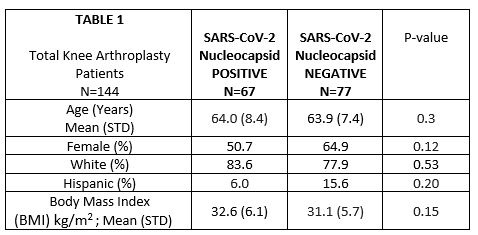Back
Poster Session B
Osteoarthritis (OA) and related disorders
Session: (0833–0849) Orthopedics, Low Back Pain, and Rehabilitation Poster
0838: Is SARS-CoV-2 Associated with Worse Outcomes After Total Knee Arthroplasty?
Sunday, November 13, 2022
9:00 AM – 10:30 AM Eastern Time
Location: Virtual Poster Hall

Lisa Mandl, MD, MPH
Hospital for Special Surgery
New York, NY, United States
Abstract Poster Presenter(s)
Lisa Mandl1, Benjamin Swett1, Robyn Lipschultz1, Myriam Lin1, Alison Zhao2, Carola Hanreich1, Dongmei Sun1, Kethy Jules-elysee1 and Friedrich Boettner1, 1Hospital for Special Surgery, New York, NY, 2Cleveland Clinic Lerner College of Medicine, Cleveland, OH
Background/Purpose: Over 520 million people have been infected by SARS-CoV-2. In 10-40%, disabling symptoms such as fatigue and dyspnea can persist. Risk factors for poor outcomes after both COVID19 and total knee arthroplasty (TKA) are similar. To our knowledge, whether previous SARS-CoV-2 infection is associated with poor outcomes after TKA has never been evaluated.
Methods: Patients with knee osteoarthritis (KOA) undergoing TKA were recruited from a single center between 10/2020 and 10/2021. Patients were screened pre-operatively for SARS-CoV-2 infection with a serum nucleocapsid IgG. SARS-CoV-2 IgG +ve patients were matched with SARS-CoV-2 IgG -ve patients without self-reported COVID19 on age (+/- 5 years), surgeon volume (< 50 TKA annually vs. > 50), and body mass index (BMI kg/m2 < 35 vs. > 35). Data were collected pre-operatively and at 6 months.
Results: 144/171 (67 SARS-CoV-2 IgG +ve cases and 77 SARS-CoV-2 IgG -ve controls) had baseline and 6-month data. Age 64 years (SD 7.8), women 58.3%, BMI 31.8 kg/m2 (SD 5.9), White 80.6%. 43/67 cases reported having had clinical symptoms attributed to COVID19, with a mean of 233.4 days (SD 125.6, range 17 - 444) between clinical COVID19 and TKA. Pre-operatively, there were no clinically meaningful differences in PROMIS-29 or KOOS scores between those with and without previous SARS-CoV-2 infection (Table 2). 6 months after TKA, there was similarly no difference in PROMIS-29, PROMIS Dyspnea, KOOS scores, or satisfaction with TKA between those with and without previous SARS-CoV-2. Among cases, there was no difference in KOOS or PROMIS-29 scores at 6-month comparing those with 0, 1-4 or > 5 COVID19 symptoms. There were, however, statistically significant Spearman correlations between time from clinical COVID19 to TKA and 6-month KOOS Pain (r=0.38 p=0.01), KOOS Function (r= 0.36 p=0.02), KOOS Symptoms (r=0.34 p=0.03), and PainDetect (r= -0.49 p=0.0013). Mean 6-month PainDetect scores were significantly lower in subjects with > 1 year between clinical COVID19 and TKA, (4.1 vs. 7.7 p=0.016). 4 subjects had neuropathic pain at 6 months; the 2 cases both had TKA < 300 days after COVID19. 1 of 2 controls had COVID19 post-TKA.
Conclusion: Previous SARS-CoV-2 infection was not associated with worse pain or function 6 months after TKA. However, a shorter time between TKA and clinical COVID19 was correlated with worse pain and function 6 months after TKA. Larger studies are needed to evaluate whether high-risk patients may benefit from delaying elective TKA 10-12 months after COVID19.

<img src=https://www.abstractscorecard.com/uploads/Tasks/upload/17574/QHOPTGBB-1287798-2-ANY.jpg width=440 height=564.145873320537 border=0 style=border-style: none;>
Disclosures: L. Mandl, Pfizer; B. Swett, None; R. Lipschultz, None; M. Lin, Pfizer, Hospital for Special Surgery Academy of Medical Educators; A. Zhao, None; C. Hanreich, None; D. Sun, None; K. Jules-elysee, None; F. Boettner, Smith and Nephew, Ortho Development.
Background/Purpose: Over 520 million people have been infected by SARS-CoV-2. In 10-40%, disabling symptoms such as fatigue and dyspnea can persist. Risk factors for poor outcomes after both COVID19 and total knee arthroplasty (TKA) are similar. To our knowledge, whether previous SARS-CoV-2 infection is associated with poor outcomes after TKA has never been evaluated.
Methods: Patients with knee osteoarthritis (KOA) undergoing TKA were recruited from a single center between 10/2020 and 10/2021. Patients were screened pre-operatively for SARS-CoV-2 infection with a serum nucleocapsid IgG. SARS-CoV-2 IgG +ve patients were matched with SARS-CoV-2 IgG -ve patients without self-reported COVID19 on age (+/- 5 years), surgeon volume (< 50 TKA annually vs. > 50), and body mass index (BMI kg/m2 < 35 vs. > 35). Data were collected pre-operatively and at 6 months.
Results: 144/171 (67 SARS-CoV-2 IgG +ve cases and 77 SARS-CoV-2 IgG -ve controls) had baseline and 6-month data. Age 64 years (SD 7.8), women 58.3%, BMI 31.8 kg/m2 (SD 5.9), White 80.6%. 43/67 cases reported having had clinical symptoms attributed to COVID19, with a mean of 233.4 days (SD 125.6, range 17 - 444) between clinical COVID19 and TKA. Pre-operatively, there were no clinically meaningful differences in PROMIS-29 or KOOS scores between those with and without previous SARS-CoV-2 infection (Table 2). 6 months after TKA, there was similarly no difference in PROMIS-29, PROMIS Dyspnea, KOOS scores, or satisfaction with TKA between those with and without previous SARS-CoV-2. Among cases, there was no difference in KOOS or PROMIS-29 scores at 6-month comparing those with 0, 1-4 or > 5 COVID19 symptoms. There were, however, statistically significant Spearman correlations between time from clinical COVID19 to TKA and 6-month KOOS Pain (r=0.38 p=0.01), KOOS Function (r= 0.36 p=0.02), KOOS Symptoms (r=0.34 p=0.03), and PainDetect (r= -0.49 p=0.0013). Mean 6-month PainDetect scores were significantly lower in subjects with > 1 year between clinical COVID19 and TKA, (4.1 vs. 7.7 p=0.016). 4 subjects had neuropathic pain at 6 months; the 2 cases both had TKA < 300 days after COVID19. 1 of 2 controls had COVID19 post-TKA.
Conclusion: Previous SARS-CoV-2 infection was not associated with worse pain or function 6 months after TKA. However, a shorter time between TKA and clinical COVID19 was correlated with worse pain and function 6 months after TKA. Larger studies are needed to evaluate whether high-risk patients may benefit from delaying elective TKA 10-12 months after COVID19.

<img src=https://www.abstractscorecard.com/uploads/Tasks/upload/17574/QHOPTGBB-1287798-2-ANY.jpg width=440 height=564.145873320537 border=0 style=border-style: none;>
PROMIS-29: T-Scores: range 0-100; 50= population mean. Higher=more of the domain being measured
KOOS Subscales: 0-100; higher is better
PainDetect: -1-38; >19= neuropathic pain
KOOS Subscales: 0-100; higher is better
PainDetect: -1-38; >19= neuropathic pain
Disclosures: L. Mandl, Pfizer; B. Swett, None; R. Lipschultz, None; M. Lin, Pfizer, Hospital for Special Surgery Academy of Medical Educators; A. Zhao, None; C. Hanreich, None; D. Sun, None; K. Jules-elysee, None; F. Boettner, Smith and Nephew, Ortho Development.

